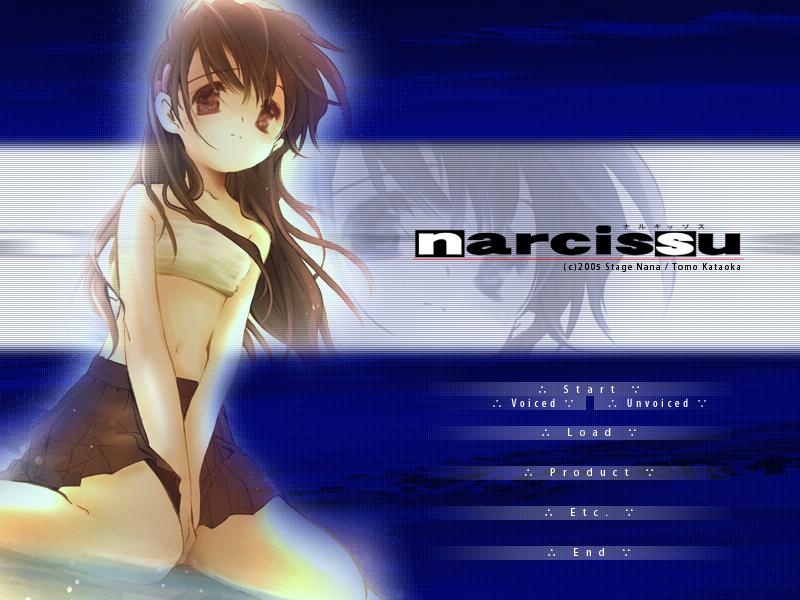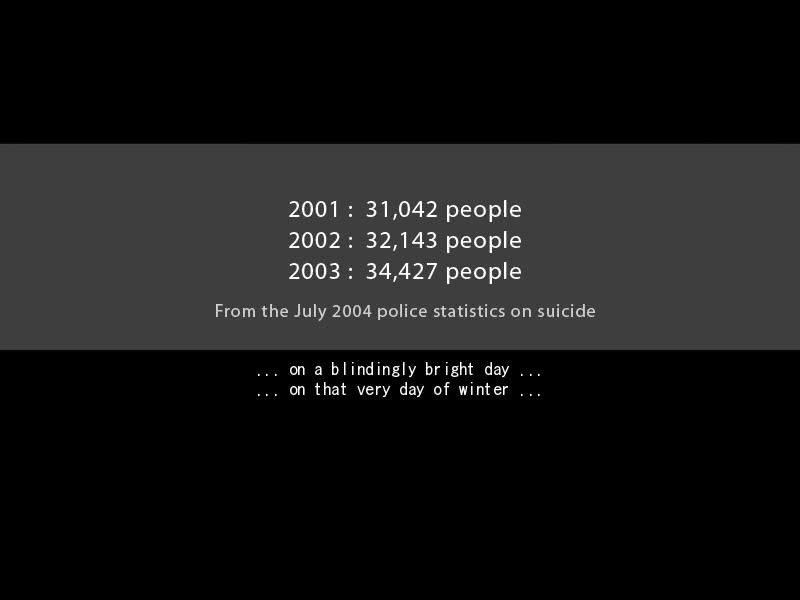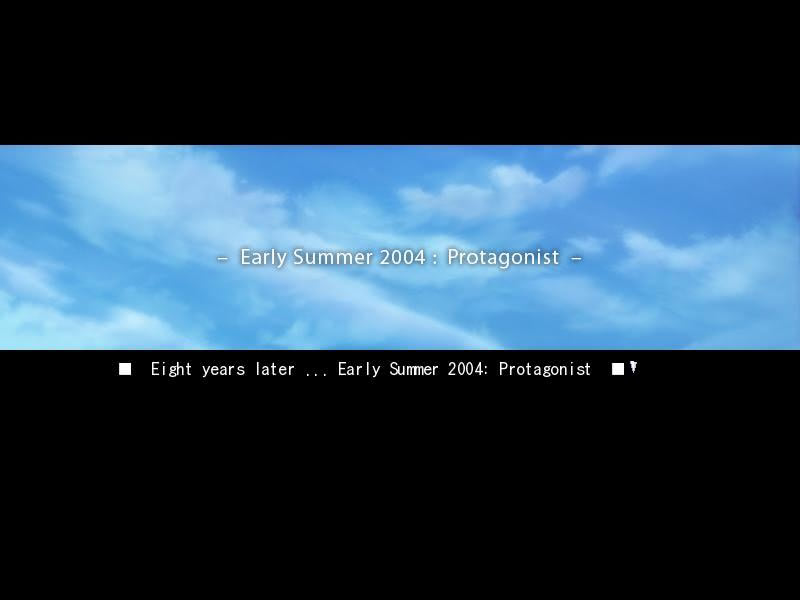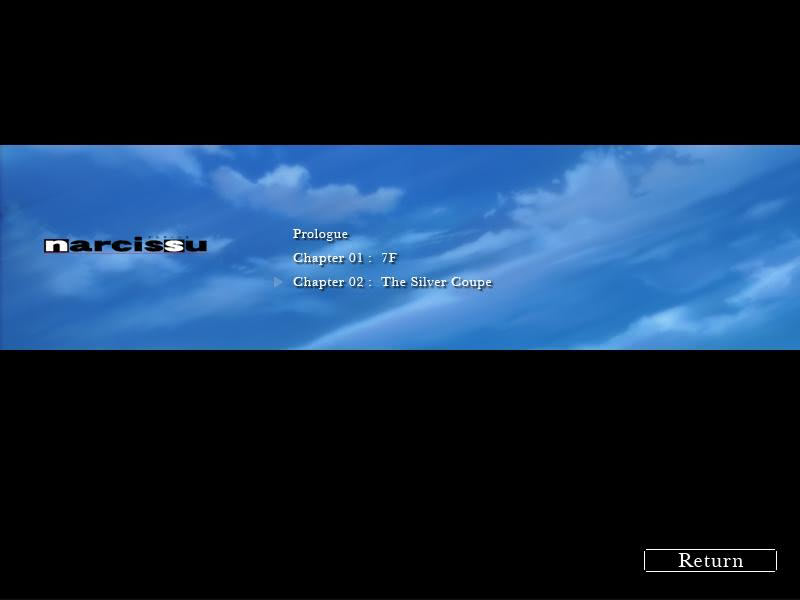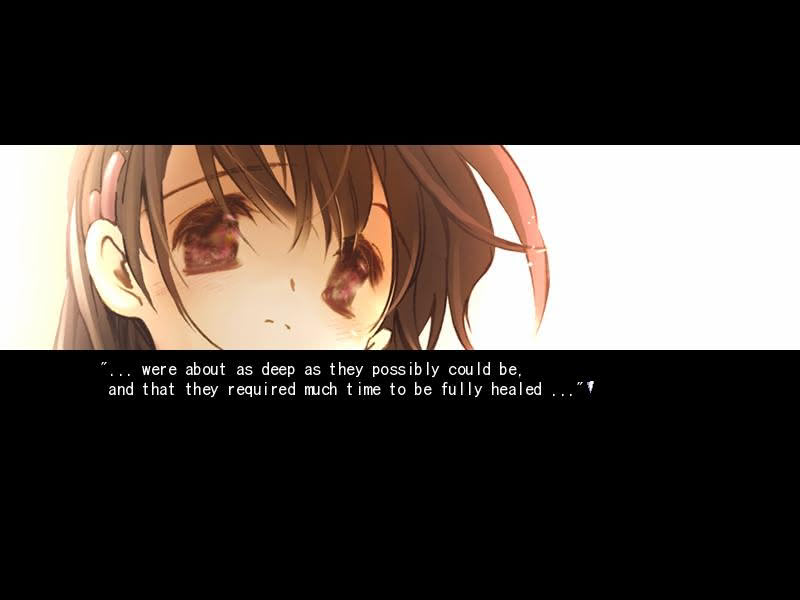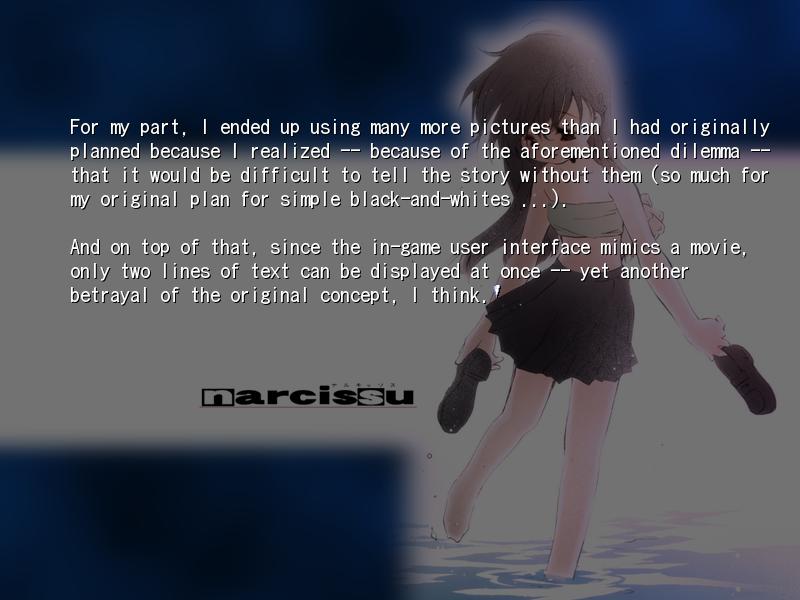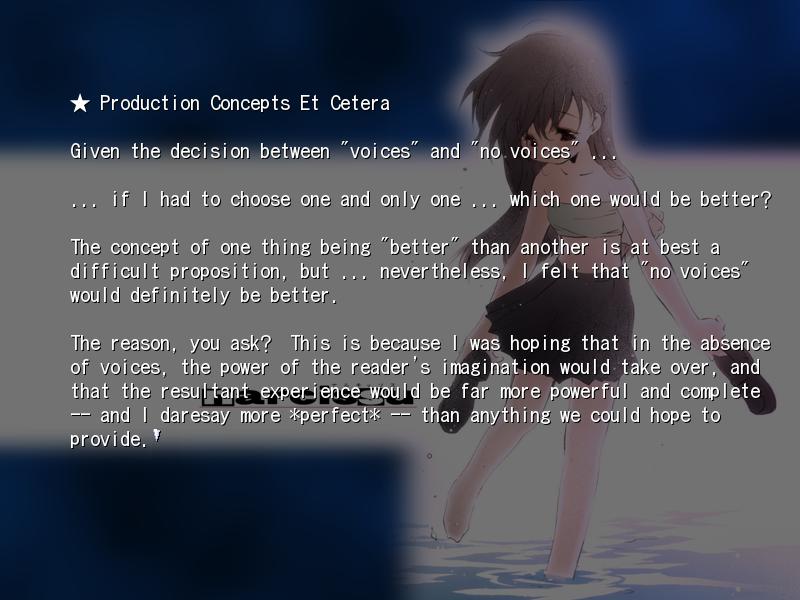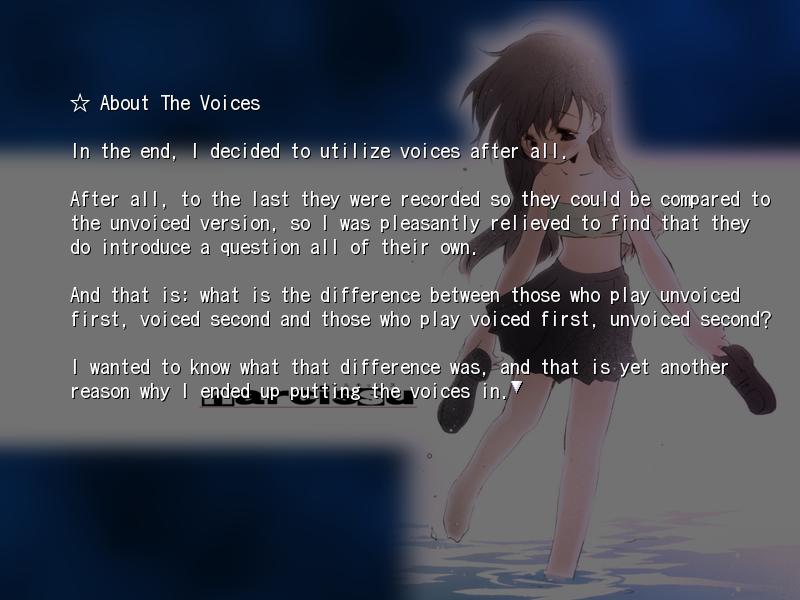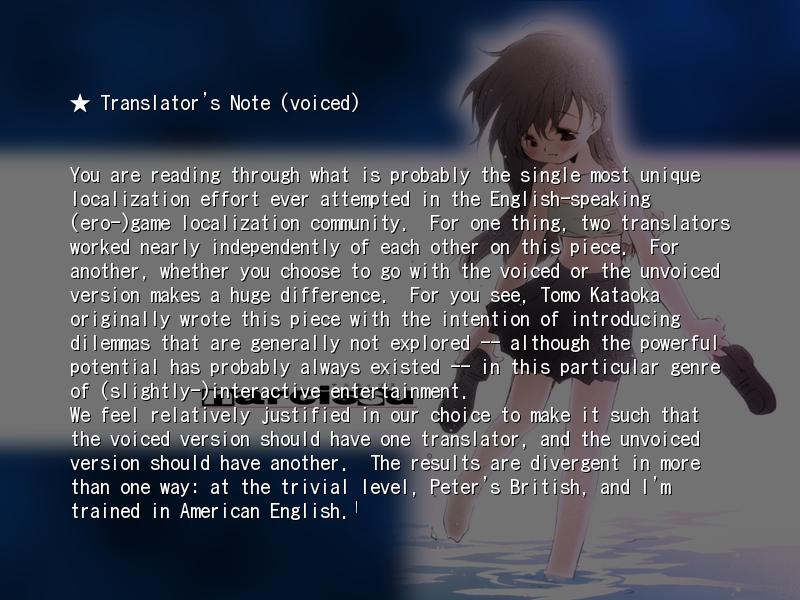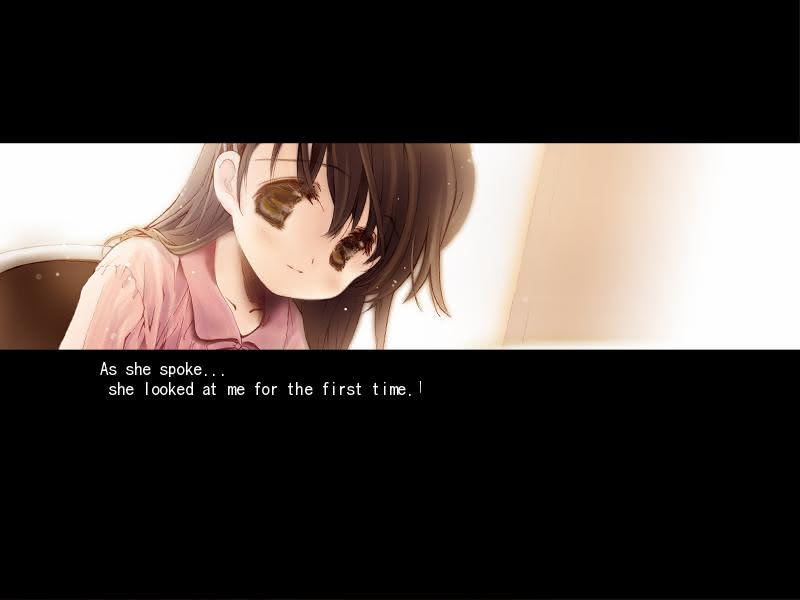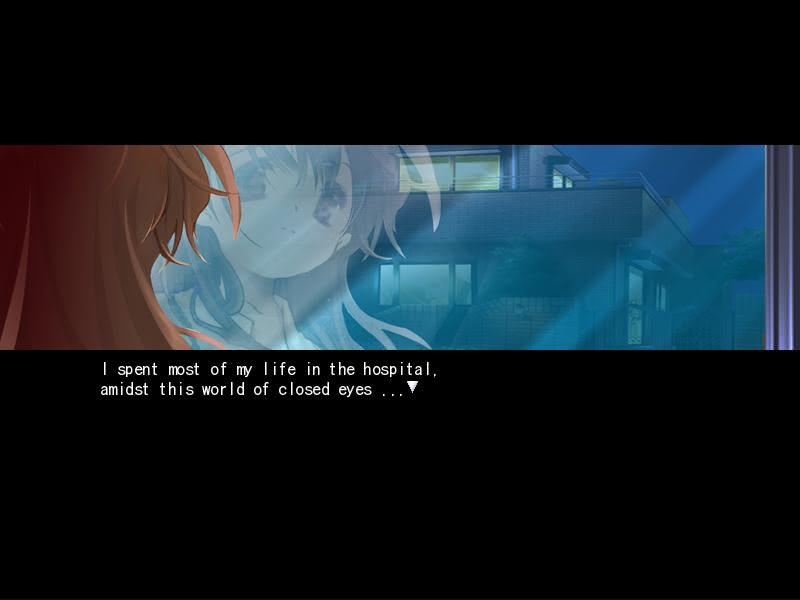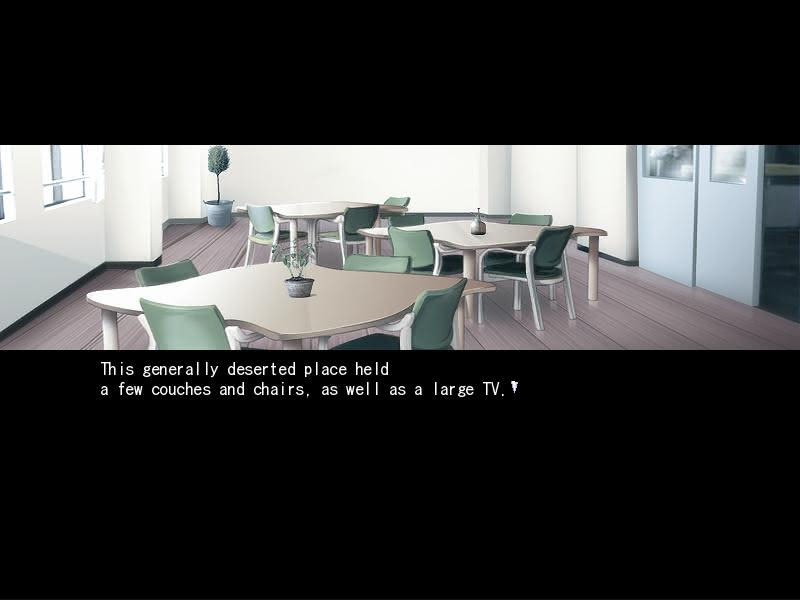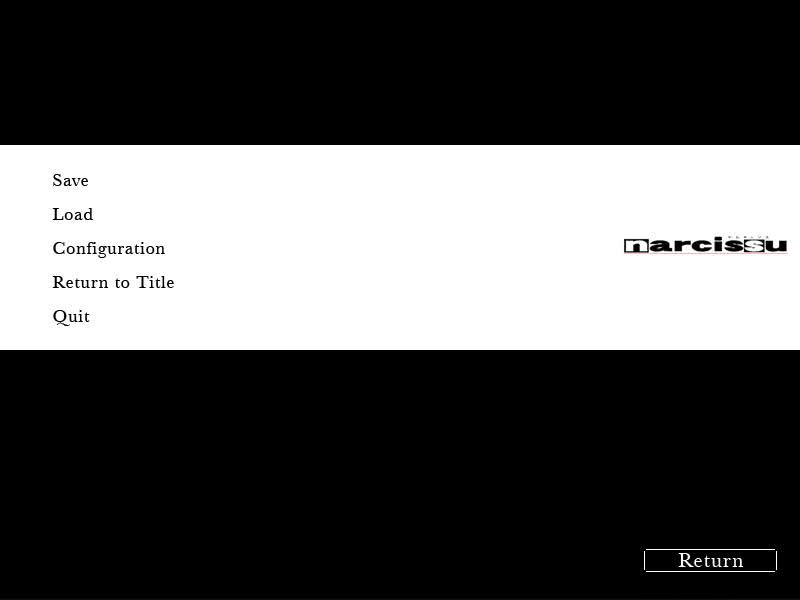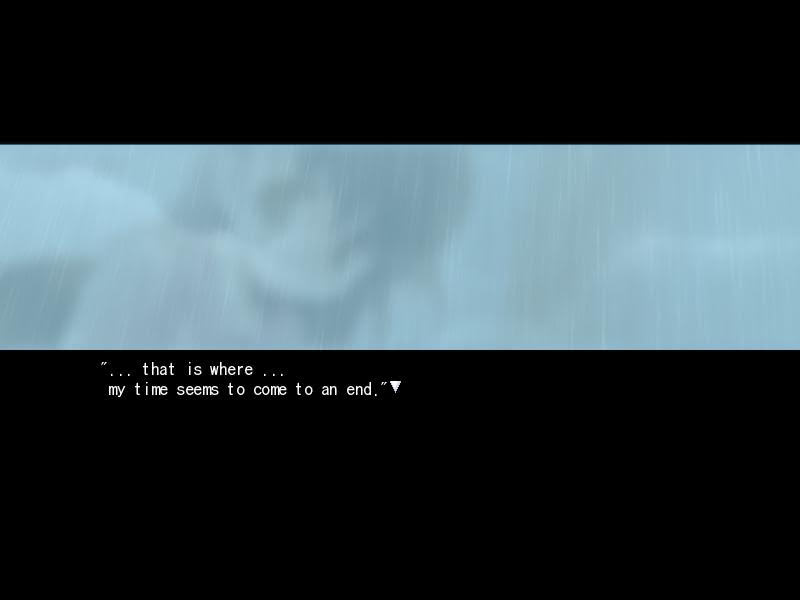Narcissu is a freeware Japanese visual novel by Stage-nana. It was first released in Japan on August 2, 2005. On August 21, 2005, Insani made available an official English translation of Narcissu, and it became the first submission to the inaugural al|together visual novel translation festival. It is unique among the al|together translations in that the translation comes with two versions of the text completed by two different translators.
Subsequent to its initial release and translation, Narcissu received several sequels and re-releases. Today, it and its sequels and sister projects are notably available on Steam and will soon be released for PlayStation 4 and Nintendo Switch. In this article, I will review Insani’s original Narcissu translation for al|together 2005 as part of my project to review almost all of the 31 visual novel translations submitted to the three al|together festivals.
You can learn more about my al|together project by reading my project introduction article. That article includes a running list of our completed al|together reviews. I have a dedicated collection post with links to all of our al|together articles, including reviews, essays, and short posts.
Narcissu is a kinetic visual novel (no choices or player input) that can be read in a couple of hours (short in the grand scheme of visual novels, but on the long end of the al|together translations). It is narrated by a 20-year old young man who has recently received a terminal diagnosis related to his heart. He is transferred to hospice care on the 7th floor of his hospital. While living in hospice care, he meets a jaded, terminally ill young woman named Setsumi Sakura, who appears to have been in hospice care for a long time already. With little to do, they spend time together as they ponder their sad circumstances, and think about weighty questions such as whether they would prefer to die at home or in the hospital.
As you can imagine from my brief intro, Narcissu is a cheery piece. Below, I offer my full review.
Narcissu details
2005 English version:
| Title | Narcissu |
| Translators | Seung Park (Insani) and Peter “Haeleth” Jolly |
| Release Date | August 21, 2005 |
| Engine | ONScripter |
| Official Websites | Insani; altogether 2005 |
Note on Insani site: Insani created a small website for Narcissu on a subdomain of its main domain. The site offers detailed context and analysis from the translators, including a lengthy essay by one of the two translators on the terminal illnesses described in the game, by Mr. Seung Park, who was a medical student at the time he completed Narcissu,. As a general matter, I would recommend reading the story before the additional context, but the home page linked in the above table is entirely free of spoilers.
Original Japanese version
| Title | Narcissu |
| Creator | Stage-nana (circle); Tomo Kataoka (writer) |
| Release Date | August 2, 2005 |
| Engine | NScripter |
| Website | Archived |
As I noted in the introduction, Narcissu has been re-translated and received sequels and sister games. While I am only looking at the original translation of the first release, you can find the new translations produced by Sekai Project on Steam for free (Steam page).
The context of my review
Most of the al|together visual novel translations are relatively obscure these days. Narcissu stands apart from the pack, both in Japan and in the English visual novel world, in that the original project has received plenty of attention in the form of remasters, re-releases, and new entries in what became a series of games.
Why then am I not reviewing the newest release and translation of Narcissu on Steam?
(Note: The free Steam release has Narcissu 1st and 2nd. The al|together 2005 translation is only of 1st. Narcissu 2nd was a separate translation project not handled by Insani.)
I set out to chronicle all of the visual novel translation projects for the 2005, 2006, and 2008 visual novel translation festivals. Thus, for the purpose of this project, I am interested in the al|together translations of Narcissu, which were done of a lightweight version of the original Japanese novel released for people with limited computer hardware and internet bandwidth. (Insani translated the web version of Narcissu, which was lighter than the first release of the novel. Insani opted for the web version because many people had more limited bandwidth in 2005 than they do today.)
As luck would have it, I have not yet read the Sekai Project translation of Narcissu or any of the other non-Insani translations of the piece. For that reason, I entered the process of reviewing the original translation in the same manner as those who read it in 2005, unburdened by comparisons, favorable or negative, to subsequent Narcissu developments.
People who are interested in Narcissu may opt for the Steam version, which includes the option to use Mr. Seung Park’s 2005 translation, the second Narcissu game, which was not part of al|together, and the option to purchase the full series collection with bonus materials. However, as I will explain below, the original Narcissu is easy to run on Windows and Linux.
Downloading and Installing Narcissu
The Insani version of Narcissu remains free to download from Insani: Official direct download and torrents. The page contains a torrent download link and link to a page with direct downloads for Windows, Linux, and MacOS. I downloaded the Windows torrent, extracted the contents, and ran it with the Galladite27’s June 28, 2023 build of ONScripter-EN for Linux with no issues whatsoever. See my guide on extracting Windows installers for ONScripter games and running them on Linux.
While direct downloads are available, the Narcissu torrents downloaded quickly for me every time I tested.
The direct download page for Narcissu also contains translations for the novel in PDF form by Mr. Randy Au, who was working on the game at the same time as Insani (unknown to both). Mr. Au’s translation would later provide the foundation for the Sekai Project version now available on Steam. I am not reviewing the PDFs in this piece since they are unrelated to the Insani version of the novel. Note that Insani also includes links to the original Japanese Narcissu written in NScripter for those of you who can read Japanese and may be interested in comparing it to the translated versions.
The versions
Narcissu has a partially voiced version and an entirely unvoiced version. The only difference between the two versions would have been that one voices one of the two main characters, Setsumi Sakura, while the other version does not voice either of the characters. However, Insani opted for an interesting course, having Mr. Seung Park translate the voiced version and Haeleth translate the unvoiced version.
The free version on Steam works a bit differently. From a quick glance, I saw that it maintains the voiced and unvoiced versions from the original. However, in this case, the player chooses between Mr. Peter Au’s translation or Insani’s translation. I quickly checked the Insani translations and found that the Steam release appears to use Mr. Park’s translation for both the voiced and unvoiced versions, which distinguishes it from the original Insani project. Thus, the only way to read the Haeleth translation is in the original Insani release. (I discuss my impressions of the two translations in the Insani version later in this article.)
A note on spoilers
Readers of Narcissu will know that the story changes lanes somewhere around the one-quarter to one-third mark of the script. A detailed analysis of Narcissu would require me to at least discuss that turning point with some specificity. However, I am inclined to be especially careful with Narcissu (not that I am negligent on spoiler avoidance in my other al|together reviews) because it, unlike the other al|together pieces, is available to download and read for free on the most popular online game store.
I opted to take the following course.
My general overview, which is the next section, includes no reference to the story’s turning point. My writing review, which is the third-to-last section of the article, indirectly references the turning point without stating what it is specifically – but in a way that people familiar with Narcissu would understand. While I think the entire review is safe to read even for those who have not yet played Narcissu and may do so in the future, not least because the novel foreshadows its twists and major events from its earliest scenes, readers may exercise discretion in determining whether to read the later script review section.
General overview
Narcissu sets its tone early as the game opens with recounting suicide statistics in Japan in the years leading up to 2005.
The al|together 2005 page for Narcissu translated Stage-nana’s brief summary of the piece:
The modern day. Dark. A protagonist and a heroine. Both of whom die.
Stage-nana
That is a bleak, albeit fair, surface summary of Narcissu.
Narcissu is set in the present day. Since it was written in 2005, it is explicitly set in 2005 with scenes within chapters being denoted by specific dates.
The main view-point character is a 20-year old young man. He had been living a normal life prior to collapsing and being diagnosed with a terminal heart condition (Mr. Park expresses high confidence about his specific diagnosis on Insani’s Narcissu site). We do not know much about him other than the fact that he went to school, hoped to get a job, and perceived himself as being distant from his parents and sister despite living with them.
On account of his condition, the protagonist is moved to a special floor of the hospital for terminal patients who are, according to the hospital, waiting for a new medical development that may change the course of their illness. There, he meets a small, frail girl named Setsumi Sakura, who says she is older than him notwithstanding the fact that she looks several years younger. Setsumi is taciturn, but she reveals the three rules of the seventh floor of the hospital that were passed down to her – namely that the third time you are discharged to spend time at home will be the final time.
While the young man is the main view-point character, there are several scenes, usually occurring at the start of a chapter, that are narrated by Setsumi. One such scene, in fact, is the novel’s opening scene after recounting suicide statistics. We know that Setsumi had been in the hospital for some time and she reveals to the view-point character that she had already been discharged twice.
Setsumi, having accepted that her life is coming to an end, thinks about where she wants to die. She tells the young man that she does not want to die in the hospital but that she also does not want to die at home. After Setsumi offers the man advice on what to do if he ever decides to run away, Setsumi disavows any specific desire to run away when pressed on the matter.
Narcissu Review
Below, I will review the different parts of Narcissu.
Estimated reading time
Visual Novel Database gives Narcissu a 3-hour reading estimate and I think that is about right for most readers. It is in the mix with Red Shift for the title of third-longest novel in the al|together set behind Collage and May Sky.
Game-play and structure
Narcissu is entirely kinetic, meaning there is no player input other than advancing the text.
It is, however, much more structured than most visual novels we have reviewed. It is organized into eight chapters, with each chapter having a name.
Many chapters are subdivided into specific dates. Upon completing a chapter, the reader can then jump to that chapter from a chapter select menu. One notable feature is that completed chapters carry over between voiced and unvoiced versions. For example, if you complete the voiced version, you can jump to any of the eight chapters in the unvoiced version as well.
Visual presentation
Narcissu has a unique visual style that distinguishes it from all of the other al|together pieces.
Narcissu, like fellow al|together 2005 submission A Winter’s Tale, makes use of letter-boxing. However, it uses much more black screen than did A Winter’s Tale, leaving only a small rectangular section for displaying an image. The text is clearly displayed below the image area.
Narcissu does not use any character sprites, but some of the background images include Setsumi.
The novel does not have a huge variety of backgrounds notwithstanding its length, but they are well-chosen to highlight different locations.
The images are often clearly based on real photographs, but of a solid quality on the whole for a freeware novel of the era.
(Technical note: Narcissu’s default resolution is 800 x 600. This is notable because almost all of the al|together games written in some flavor of ONScripter default to 640 x 480. Note, however, that the resolution can be changed at launch.)
Music and sound effects
Narcissu has a total of 12 background music tracks, which are available in a menu jukebox post-completion.
Most of the tracks (two exceptions) are about as melancholy as one may expect from the subject-matter. Two of the tracks are voiced. All of the tracks fit Narcissu’s mood well and the novel did a solid job of using them effectively and mixing them up to keep things from becoming repetitive. I did not note any jarring transitions.
My favorite of the regular tracks is Lammune 79’s and the best of the voiced tracks (as well as best overall) is the vocal version of Narcissu’s theme song.
Translation analysis
As always, I preface my translation analysis by noting that I neither speak nor read Japanese. Thus, my assessment is based solely on how well the novel reads in English and the extent to which it expresses what I understand to be the novel’s points and sentiments in a clear, natural way.
Narcissu is unique in al|together in that it has two translations. The dual-track approach was inspired by the fact that the circle that created Narcissu, Stage-nana, opted to create a voiced and unvoiced version of the game in Japanese. That was the circle’s solution for resolving indecision about whether to use a voice actress for Setsumi or leave her voice to the reader’s imagination. However, in Japanese, the script was unchanged between the two versions (I noted the free release on Steam uses Mr. Park’s translation for both the voiced and unvoiced versions if the player chooses the Insani translation).
Insani decided that it would be interesting to have two different scripts, one for the voiced version and one for the unvoiced version. The translator for the voiced version was Mr. Seung Park, who led Insani through the three festivals and translated a number of other novels that we reviewed (while supervising several translations in cases he was not the lead translator). The unvoiced version was translated by Haeleth, who headed the al|together 2006 festival and was the original maintainer of what its now ONScripter-EN.
Two things jump out quickly while comparing the translations. Haeleth’s translation reads more casually than Mr. Park’s. While Mr. Park himself rejects the idea of aspiring for a literal word-to-word rendition of Japanese to English on account of the fact that this would not convey the meaning contained in Japanese text, I came away with the impression – possibly inaccurate since I cannot read Japanese – that Mr. Park’s translation was more formal. The second notable point is that Haeleth is British whereas Mr. Park is American. There are several points where Haeleth’s UK-English kicks in – for example his use of “swimming costume” instead of swimsuit.
Note that I had no issue with the instances of UK-English and they were all perfectly intelligible to me as an American. I note it as a point of interest.
I read Mr. Park’s translation first and ultimately did not find that I came away with a very different impression of the story from the Haeleth version (I count this as a good thing). While they read differently at points, they both convey the same ideas and themes about life and death, which I assume hew closely to the original Japanese script. I will, however, highlight two early points where I thought the translations diverged in a meaningful way, albeit not in a manner that changes how one would read the story in a broad sense. There is an early scene wherein Yuu returns home from the hospital to spend New Years with his family. I explained briefly that Yuu felt distant from his family. Mr. Park’s translation makes Yuu sound more negative toward his family than does Haeleth’s translation, and I would prefer that Haeleth had interpreted the scene better for the sake of the story – but I do not know if this is the case. Conversely, there is a scene not too long after when Yuu’s father visits him at the hospital. In this case, the roles are reversed – while the impression of Yuu’s interaction with his father is negative in both cases, Mr. Park portrays Yuu as more detached and jaded whereas the Haeleth translation paints Yuu’s father in a much more negative light.
Separate and apart from the voices or no voices issue, I usually preferred Mr. Park’s translation to Haeleth’s. It is more consistent, reads more clearly, and lacks some of the occasionally noticeable errors and awkward phrasing in the Haeleth version. There are instances, especially in the early going, where I think Haeleth’s more approach produces slightly more natural interactions between Yuu and Setsumi, but over the course of the novel, the balance tilts clearly toward Mr. Park’s having produced a text that reads better to me as an English visual novel reader. Haeleth’s effort is, however, solid – especially given Narcissu’s length and nuance, and it rates well in the grand scheme of al|together translation efforts even though Narcissu was likely among the more labor intensive of the novels due to the length of its script and its subject-matter.
On the voicing issue, I prefer having Setsumi voiced for two reasons. For one, I think her voice acting is solid. For two, it resolves the occasional issue of losing track of whether she or Yuu is speaking, which is a consistent minor niggle in some of the al|together pieces. However, the voicing issue is a matter of taste and I could see why one may prefer no voices. As I noted earlier, the Steam version allows you to read Mr. Park’s translation with no voices – a combination that is not possible in the 2005 Insani version.
Writing and story quality
Note: While I think I avoid spoilers enough that this section is fine for those who may play Narcissu in the future, others may prefer to read the novel before reading my assessment..
Narcissu, like many freeware novels of the era, has an interest in terminal illness, death, and tragedy. However, where a terminally ill character was either an aside (e.g., Plain Song) or in the past (e.g., From the Bottom of the Heart) in other pieces I reviewed, Narcissu is entirely about two young adults being forced to confront their impending deaths and the sense that world had moved on, and would continue to move on, without them. Given the trends in visual novel stories of the day (and today, to an extent) and Narcissu’s generally above average production values for a freeware project, I am not surprised that it emerged as the most popular of the novels translated for al|together.
To begin, I think that the best way to read Narcissu is as a story that tells the reader how things are for two terminally ill young people – primarily Setsumi despite the fact she is not the main view-point character – rather than conveying some idea of what they should be. It is Sophocles rather than Aeschylus or Euripides (take that metaphor as far as you want to take it). Moreover, understanding Narcissu requires understanding how Setsumi sees and understands the world and her sad and dwindling life, and the effect that her worldview has on Yuu.
In the postscript, the author leaves it up to readers to understand the story as they will and declines to delve into how his story makes him feel. This has the effect of distinguishing Narcissu from al|together pieces which express a more clear point of view for how the characters should live their lives. For example, in my view the other al|together piece that centered primarily on terminal illness, From the Bottom of the Heart focuses on delivering a particular point of view about the two main characters and how they should move forward. One of Mr. Park’s later al|together translations, The Letter for 2008, focuses significantly on a character who died in the past but, in so doing, has a message to deliver about the present. Narcissu’s focus – as I interpret it, at least – is on asking readers to follow a story and empathize with the characters rather than to take something specific from the author. This style made me think just a bit of the one al|together piece that may be even bleaker than Narcissu, Flanca (Flanca is one of two novels that make up al|together 2006’s The world to reverse). I noted that while Flanca is compelling, it is not clear what one should take from it. A similar critique can be lodged against Narcissu, but I do think it is distinguishable (beyond the different content) in that the author wanted readers to see the world through the eyes of his two protagonists.
For the good, Narcissu is generally well-written and well-constructed on the whole, with a coherent script that gets from introducing the characters and their bleak circumstances at point A to the end of their journey together at point B. Of the two, Setsumi, despite often being reluctant to speak, is the defining character of the piece and comes through more strongly than the primary view-point character. We learn about how she went from being a normal girl, to someone who lost touch with the outside world during her long hospitalization, receding into a world that existed in books, magazines, and on her television screen, and who became resigned to her fate but seemingly opposed to every way it might come about. Narcissu asks its readers for empathy, to understand how a young woman in Setsumi’s position would feel about her circumstances and the world around her, and it does a very effective job of using her truncated dialogue and a few select internal monologues to tell us. We know a bit less about the view-point protagonist, who seems to have been a normal young man prior to suddenly being hospitalized and told that his life was near its end. He enters the 7th floor of the hospital disaffected. To say Setsumi changes his perspective may be going too far, but it is his encounter with Setsumi that inspires him to undertake a journey for himself, for Setsumi, or for something he could not define himself.
Narcissu comes with some writing points that I count as demerits. Firstly, the portrayal of the view-point protagonist’s relationship with his family felt off – regardless of which of the two translations (recall I found they gave different impressions of the two key scenes concerning his family) was more on point. It is clear that the view-point protagonist believes his family does not care about him. Is this actually the case or is this just his perspective? The novel drops some hints that it is not entirely in the protagonist’s head, notwithstanding the fact that his family sounds normal by all accounts, but the writing felt heavy-handed. It is not an insignificant issue since the feeling of abandonment plays a role in motivating the protagonist’s key decisions, along with having talked to Setsumi, to dramatically change the course of Narcissu’s story.
My second similar issue has to do with the portrayal of the hospital’s 7th floor, which makes the entire facility seem like a sort of bureaucratic prison and made me wonder whether the author of Narcissu has a generally negative view of hospitals. Mr. Park opined in an essay on medicine in Narcissu (note his final take away comes off less negative on this point than mine) that “[w]hether intentionally or unintentionally, [the author] Tomo Kataoka paints Hospice in a very negative light in this piece.” He added, and I agree, that “the patients on 7F are portrayed as being prisoners of a sort.” Mr. Park suggested that this could simply be the narrator’s view-point, which is similar to my suggestion on the family issue above – but I think not in this case since Setsumi appears to have a largely similar view. My issues here are two-fold. Firstly, it is jarring to give Narcissu a very real-world setting noting real locations in Japan on real, then-present-day dates, and then take so many liberties in portraying the hospital’s hospice ward in a negative light. Secondly, I think this is another case of Narcissu being heavy-handed in setting up its story.
I have a general aversion to heavy-handedness in portraying people and entities in a negative way as a shortcut to setting up a scenario. I noted similar issues in a recent anime of The Angel Next Door Spoils Me Rotten. Although I had a generally positive view of the series, the trauma of one of the characters depended on making the character’s parents not only callous, but comically so. In this case, the brute force portrayal of the view-point protagonist’s family and the coldness of the hospital’s hospice ward, neither of which can readily be waved away on “matter of perspective” grounds, played a role – not the sole role, but an important role – in setting the stage for Yuu and Setsumi’s decisions. A subtler approach that provided a more balanced view of the world around the view-point protagonist and Setsumi could have set up the story more elegantly than relying solely on Setsumi’s alienation and the effect she has on clarifying the viewpoint protagonist’s view of his own circumstances.
Technical points
Narcissu comes with a number of save slots, but the chapter select menu and the reasonable length of the chapters renders saving almost entirely unnecessary.
Narcissu has a conventional menu but it looks better than the default NScripter menus seen in many of the al|together projects with some aesthetic branding.
The additional config mode offers fine-tuned options for configuring voices (in the voiced version), music, and sound effects.
Narcissu comes with a significant amount of post-game content, including statements from the creator and Insani. The statements by Stage-nana and Mr. Park are very good and among the better post-game content in an al|together novel. I highly recommend reading them to learn more about the author’s intent in creating Narcissu and the interesting decisions made in creating the English version.
Conclusion
After reading Narcissu, I can see why it emerged as the most popular of the novels submitted to and translated for al|together. It tackles a serious and weighty topic head on and makes an effort, admittedly imperfect, to invite readers to see the world through the eyes of two people whose time is running out due to little more than terrible luck and who struggle to relate to happier times in their lives when they moved with the world instead of standing apart from it.
Notwithstanding Narcissu’s minimalist aesthetic, it has some of the stronger production values of the al|together set. Granting some of my qualms, it is a fine piece worth reading for people who can handle the bleak subject-matter, and it is certainly a must-read at least once for Japanese visual novel fans and those specifically interested in the era of novels covered by the al|together translations. Separate from the novel itself, Narcissu was a historically significant translation in that it was the first piece translated for al|together and the first example of English localizers working with the original creator of the Japanese doujin visual novel to create an English version.
